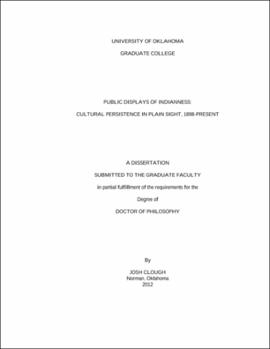| dc.contributor.advisor | Watkins, Joe | |
| dc.creator | Clough, Josh | |
| dc.date.accessioned | 2019-04-27T21:29:42Z | |
| dc.date.available | 2019-04-27T21:29:42Z | |
| dc.date.issued | 2012 | |
| dc.identifier | 99234335302042 | |
| dc.identifier.uri | https://hdl.handle.net/11244/318829 | |
| dc.description.abstract | This work examines the ways in which various American Indian groups and individuals have presented aspects of their cultures publicly over the last century, especially at events and venues considered to be non-Indian in origin. The intersection of American popular culture and Indigenous cultural representation presents unique opportunities to explore important issues that Native American people have faced over the last hundred years--assimilation policies of the federal government, retention of traditional cultural practices, and combating stereotypes of Indians created by the dominant society, to name just a few. Exhibits of Indian products (and Indians themselves) at fairs and expositions are beginning to receive the scholarly attention they deserve because of the copious coverage of them by the press and the window into contemporary Native life that they offer. For this study, the involvement of Indian people in three distinct fairs--the 1898 Omaha Exposition, the Cheyenne-Arapaho Indian Fair, and the American Indian Exposition--is explored to demonstrate the degree to which the Native participants both shaped and were shaped by these events. | |
| dc.description.abstract | The latter chapters of the dissertation focus on the issues of Indigenous representation in Indian princess pageants, tourist villages, and dance exhibitions. It is safe to say that many Americans, to the extent that they have any concept of Native Americans at all, have formed their views of American Indians to a great extent on how they have encountered them on vacation, at school, or at some public place outside of a Native community. How "authentic" is this image, though, given the out-of-context performances that are being presented? Issues of cultural concessions and cultural revitalization, as well as Native control of their own image, are examined to better understand the notion of representation from the representatives themselves. I conclude the dissertation with a description of how Indian tribes and individuals today are using public dance performances to perpetuate, reinvigorate, and/or recreate aspects of their cultures. As well, the use of performance to reintroduce culture to individuals detached from their respective tribes will be discussed to demonstrate that dance can and does have the power to heal. | |
| dc.format.extent | 259 pages | |
| dc.format.medium | application.pdf | |
| dc.language | en_US | |
| dc.relation.requires | Adobe Acrobat Reader | |
| dc.subject | Indians of North America--Exhibitions--History | |
| dc.subject | Indians of North America--Ethnic identity | |
| dc.subject | Indians in popular culture | |
| dc.subject | Indians of North America--Public opinion | |
| dc.subject | Indian tourism | |
| dc.subject | Heritage tourism | |
| dc.title | Public Displays of Indianness: Cultural Persistence in Plain Sight, 1898-Present | |
| dc.type | text | |
| dc.type | document | |
| dc.thesis.degree | Ph.D. | |
| ou.group | Graduate College | |
